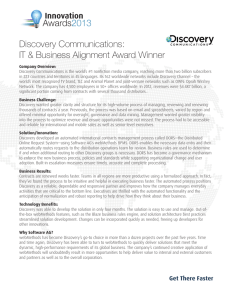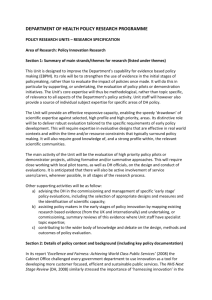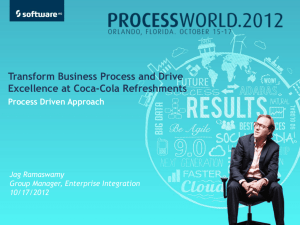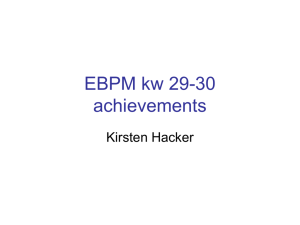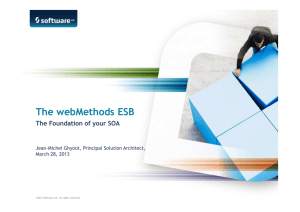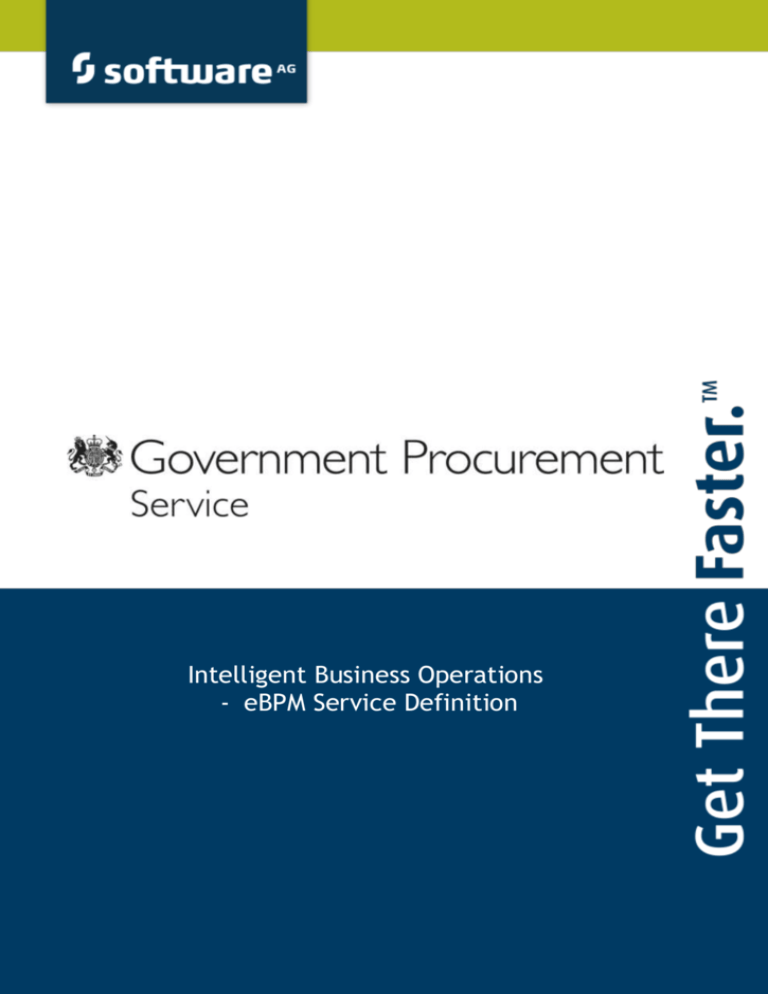
Intelligent Business Operations
- eBPM Service Definition
Software AG eBPM Serivce Definiton
Table of Contents
1.0
1.1
2.0
2.1
3.0
3.1
3.2
4.0
4.1
4.2
4.3
5.0
5.1
5.2
6.0
7.0
7.1
7.2
7.3
8.0
8.1
9.0
10.0
10.1
10.2
10.3
10.4
11.0
12.0
SERVICE OVERVIEW ........................................................................................................................... 3
APPROACH............................................................................................................................................... 4
SOFTWARE COMPONENTS ................................................................................................................ 6
ADABAS / NATURAL ................................................................................................................................ 8
SERVICE DEVELOPMENT .................................................................................................................. 8
BASELINE TOOLING CAPABILITY ............................................................................................................. 8
SERVICE ACCESS MECHANISMS .............................................................................................................. 9
SERVICE & APPLICATION MANAGEMENT .................................................................................. 9
SERVICE LEVEL DESCRIPTION ................................................................................................................. 9
SERVICE CONSTRAINTS ......................................................................................................................... 10
TECHNICAL ACCOUNT MANAGER ......................................................................................................... 10
HOSTING................................................................................................................................................ 11
SERVICE CREDITS .................................................................................................................................. 11
BACKUP/RESTORE AND DISASTER RECOVERY ...................................................................................... 11
INFORMATION ASSURANCE ........................................................................................................... 12
ON-BOARDING AND OFF-BOARDING ........................................................................................... 12
ON-BOARDING ....................................................................................................................................... 12
OFF-BOARDING...................................................................................................................................... 12
DATA EXTRACTION ............................................................................................................................... 12
INTELLECTUAL PROPERTY RIGHTS ........................................................................................... 12
ACCEPTABLE USE OF SERVICE .............................................................................................................. 12
TRAINING .............................................................................................................................................. 12
ORDER AND INVOICING PROCESS................................................................................................ 13
CONTACTS ............................................................................................................................................. 13
SCHEDULE ............................................................................................................................................. 13
TERMS ................................................................................................................................................... 13
UNIT TRACKING AND ANNUAL REVIEW ................................................................................................ 13
TERMINATION ..................................................................................................................................... 14
CUSTOMER RESPONSIBILITIES ..................................................................................................... 14
Copyright © 2013 Software AG
©2013 Software AG. All rights reserved.
Page 2 of 15
Software AG eBPM Serivce Definiton
1.0 SERVICE OVERVIEW
Software AG’s Enterprise Business Process Management solution allows organisations to buy the
service on a per unit basis. This service can be adapted to support numerous business segments
within a single named Government Department, Agency or Trading Fund to deliver an Intelligent
Business Operations (IBO) capability.
Through our proven Process Improvement Methodology (PRIME) enabled by Software AG’s Aris and
webMethods software suites, a Government organisation can align business and ICT around a
defined set of objectives to increase operational efficiency and effectiveness. The diagram below
represents the capability areas the solution supports.
The eBPM service includes a comprehensive, easy to use development and management interface
for adapting any assets/services developed on this platform.
User and role based access controls will ensure a user only sees information relevant to the defined
policy. Data at rest and in transit can be encrypted and includes full support for digital certificates
and protocols such as SSL/TLS & SAML. The named software components have been tested and
deployed in highly secure environments operating at Impact Level 5/6.
The eBPM software as a service is deployed in a Government Private Cloud environment through 3rd
party hosting companies.
Over 10,000 Government and private sector organisations have deployed Software AG’s products
and services for use within a process improvement programme. These include HMRC, Home Office,
US Department of Defence, UK Police, UK Local Government, Government Intelligence, BP, DHL, JP
Morgan Chase, Orange, Vodafone, Sainsbury’s, John Lewis, Boeing, BAE and many others.
©2013 Software AG. All rights reserved.
Page 3 of 15
Software AG eBPM Serivce Definiton
1.1
Approach
Building an Intelligent Business Operation (IBO) starts by understanding the corporate vision,
strategic goals and key performance indicators whilst ensuring the underlying processes and ICT
align with it. This relationship is captured within a model and evolves based on numerous external
and internal factors driving change. The model will be developed collaboratively with various key
stakeholders and maintained over time to ensure the IBO programme is delivering on corporate
objectives.
Process areas that are identified for business improvement go through a governance board for
review and approval ahead of moving into delivery. Approved projects are managed within Projects
& Portfolio Management function.
©2013 Software AG. All rights reserved.
Page 4 of 15
Software AG eBPM Serivce Definiton
The Carnegie Mellon research institute’s CMMI process maturity model is used to assess which stage
a delivered (individual) process is currently sitting at. As an organization changes shape over time
e.g. corporate re-structure, the underlying process maturity will also change. This emphasizes the
need to keep strategy and process execution closely aligned.
An example individual “Employee Lifecycle” process improvement project is shown below for
managing employees from initial recruitment through to retirement including the steps for
automating it using technology. This process would sit within the portfolio and have a
corresponding maturity measure on the overarching IBO programme dashboard shown above.
Each individual process will link to appropriate underlying sources of data needed to complete its
task. Where there are inconsistent data sets, a reference data model will be built to support the
process execution.
All process applications are fully governed and monitored from design-time, run-time through to
retirement.
©2013 Software AG. All rights reserved.
Page 5 of 15
Software AG eBPM Serivce Definiton
2.0 SOFTWARE COMPONENTS
The eBPM service includes the functional software components detailed in the diagram below.
At a high level the key features and modules include:
Model and manage business processes and enterprise architectures with Aris Technical
Architect and Aris Business Architect
Create process based automated applications within a service oriented architecture with
webMethods Business Process Management and Composite Application Framework
Simulate changes in processes to measure the effect of change with webMethods Simulator
and Aris Process Performance Manager
Integrate with underlying applications and transform data both internally and externally to
the subscribing Government service with webMethods ESB (service orchestration) and
webMethods Nirvana (a messaging bus)
©2013 Software AG. All rights reserved.
Page 6 of 15
Software AG eBPM Serivce Definiton
Create and manage reference data sets through the use of Master Data Management
technology with webMethods MDM
Monitor the services & events in near real-time measuring key performance indicators with
webMethods Optimise for Infrastructure, Optimise for Process and Apama Complex Event
Processing
Govern the life cycle of the assets created within this service both during design and runtime with Centrasite ActiveSOA, webMethods Mediator and Aris Process Governance.
Create and manage rules that control the flow of information with webMethods Business
Rules
Create and manage mobile applications across all the key operating systems including iOS,
Android, Blackberry and many others using webMethods Mobile Suite
Seamlessly integrate and manage business2business partners supporting standards such as
EDI with webMethods Trading Networks
Run data sets for each developed application “In Memory” thereby increasing scalability
and response times with Terracotta BigMemory
Display KPI’s on web based dashboards with Aris Mashzone or Jackbe Presto
Publish and manage assets to be accessible through the web with Aris Business Publisher
These components provide the capability to support all the Government Information Management
principles.
Software AG’s Aris and webMethods suites are released as an integrated set of open standards
based software modules. Business & IT designed assets within Aris, can be automatically moved into
a webMethods execution environment for automation using the BPMN 2.0 or EPC standards. Changes
in either the Aris or webMethods layers are synchronized with each other using Software AG’s
“Module to Execute” capability significantly reducing the cost of maintaining the platform through
life.
Each module has standard interfaces that allow organisations to use / replace with equivalent
competitive 3rd party technologies. Use of 3rd party equivalent products would increase the through
life management costs for the IBO capability as it would fall on the service provider to maintain the
appropriate level of integration across all of the software modules as opposed to leveraging
Software AG’s “pre-release suite testing” during our product development lifecycle.
Please see below for the list of components and their associated interface standards:
webMethods
o BPM – BPMN v2.0
o Business Rules – Acts as a service on the ESB (see ESB below)
o Optimise for Process – BPMN v2.0
o Optimise for Infrastructure - WS-*, SOAP, REST & XML
o ESB + Nirvana – Various standards including but not limited to WS-*, SOAP, REST & XML
o MDM – WS-*, SOAP, REST & XML
o Mediator - WS-*, SOAP, REST & XML
o Trading Networks – Various including EDI, SFTP
o Mobile Suite – Java, C Objective
Big Fast Data
o Terracotta Big Memory – Java
o Apama CEP - WS-*, SOAP, REST & XML
Aris
o Business Architect – BPMN v2.0, ITIL, MODAF, Archimate
o Technical Architect - BPMN v2.0, ITIL, MODAF, Archimate
o Mashzone – JDBC, HTTP
o Publisher - HTTP
o Process Governance - CORBA
o PPM (Process Performance Manager) – JDBC
Centrasite – XQuery, XML, HTTP, JAXR
©2013 Software AG. All rights reserved.
Page 7 of 15
Software AG eBPM Serivce Definiton
2.1
Adabas / Natural
Optionally Software AG can provide our Adabas & Natural technology for modernizing the
underlying database and application estate. Further details on this are available upon request.
3.0 SERVICE DEVELOPMENT
By way of an example and to help provide some guidance on typical costs for a process
improvement development project, organisations can categorize them into Simple, Medium or High
complexity process applications. The following key variables would need to be considered to
determine the level of complexity for each process application.
Process Complexity
L - This type of process model will have one or few ESB services of low/medium complexity
for each step in a process model.
M - This type of process model will have a few ESB services with medium/high complexity
for each step in the process model and one or two adapter interfaces with one correlation
step in the process model.
H - This type of process model will have a couple of ESB services with med/high complexity,
a couple of adapter interfaces, and a couple of correlation steps.
Quality of Service
L – No logging of QoS, Process run on a single node, Process steps run in memory during
processing
M - Error logging of QoS, Process run on a single node, Process steps written to disk during
processing
H – Full logging of QoS, Process run across multiple nodes, Process steps written to disk
during processing
Number of Process Models
Number of Steps in a Process Model
Simple complexity process applications typically take 6 months from project kick-off to go-live to
be built and delivered by a core team of 4-6 people. The team would consist of 1 Project Manager,
1 Lead Architect, 2 Developers and 1 Business Analyst. This core team would work in parallel with
the infrastructure and security teams to complete the project. The complete project cost would
typically be around £750,000-£1,000,000.
Medium complexity process applications typically take 6-9 months from project kick-off to go-live
to be built and delivered by a core team of 4-6 people. The team would consist of 1 Project
Manager, 1 Lead Architect, 2 Developers and 1 Business Analyst. This core team would work in
parallel with the infrastructure and security teams to complete the project. The complete project
cost would typically be around £1,000,000-£1,250,000.
High complexity process applications typically take 9-12 months from project kick-off to go-live to
be built and delivered by a core team of 4-6 people. The team would consist of 1 Project Manager,
1 Lead Architect, 2 Developers and 1 Business Analyst. This core team would work in parallel with
the infrastructure and security teams to complete the project. The complete project cost would
typically be around £1,250,000-£1,500,000.
3.1
Baseline Tooling Capability
Prior to the creation of new applications / services, it is essential to carefully plan the installation
of the components involved, manage the overall environment(s) and ensure that any required
supporting elements are in place at the appropriate time. Failure to do this successfully will create
unexpected downstream delay.
This baseline service capability would need to evolve as each project is delivered. This would
include (but not limited to) standards definitions, security policies, governance structures, service
management and supporting operational processes.
©2013 Software AG. All rights reserved.
Page 8 of 15
Software AG eBPM Serivce Definiton
From design through to deployment, we would estimate a cost between £100,000 and £150,000 to
deliver the tooling baseline capability.
Software AG Global Consulting Services will manage the webMethods and Aris applications working
underneath our system integration partner providing the overall eBPM service.
3.2
Service Access Mechanisms
There are various methods of accessing the application components described within this service.
Most are web based which support IE, Firefox and Chrome browsers however for mobile solutions it
allows usage of others such as Safari (but not limited to).
Some components have desktop fat clients as optional user interfaces or interactions through email
clients depending on the defined business process.
4.0 SERVICE & APPLICATION MANAGEMENT
To support client applications through their lifecycle, Software AG offers a flexible ITIL based fully
managed support service that can be tailored to meet our customers’ needs from basic application
support to a fully hosted managed service all covered within agreed Service Levels. There are three
flexible service categories, Bronze, Silver and Gold managed by a lead Technical Account Manager.
4.1
Service Level Description
The application management service can include:
Service Management Including:
o
Service Level Management
Standard SLA
Enhanced SLA
o
Incident Management with a resolution target of less than 1 standard support day for
severity 1 incidents
o
Problem Management including:
Problem diagnosis and resolution
Root cause analysis
o
Change Management
o
Release Management
o
Configuration Management
o
Capacity Management
o
IT Service Continuity Management
o
Availability Management of up to 99.95%
o
Security Management
o
Service Reporting
o
Application Response Times depend heavily on the type of transaction being processed
but typically should fall within sub second
Support mailbox and self-service support
Service desk, support mailboxes and self-service support
o
Standard office hours of 09:00 – 17:30 Monday to Friday excluding bank holidays
©2013 Software AG. All rights reserved.
Page 9 of 15
Software AG eBPM Serivce Definiton
o
Extended office hours available for severity 1 incidents
o
Support is accessible through Software AG telephone and email channels details of
which can be found at www.softwareag.com or through your Technical Account
Manager
System Monitoring
Remote Access
Knowledge base administration
Disaster Recovery support
Out of hours support administration
System Hosting and Patching
Secure machine rooms
Security Cleared consultants
24*7 support /extended hours
Technical Account Management
Call-off days
4.2
Service Constraints
No Service constraints exist beyond the scope of which individual product components are
purchased and their associated terms & conditions.
For the hosting service, “Planned” and “Emergency” maintenance constraints are detailed within
the respective aforementioned G-Cloud service providers Lot 1 & Lot 2 entries.
4.3
Technical Account Manager
The Technical Account Manager is a security cleared, dedicated, available on-site consultant who
adopts a formal and structured approach to managing the Client’s technical needs. The Technical
Account Manager is also a hands-on, client-facing person that will support Client projects as well as
take ownership of problem resolution.
They will also act as an expert communications link between the client and appropriate Software
AG resources e.g. support teams and product experts. Working with the Client Engagement
Manager, they can present technical solutions to non-technical people as well as developers.
The Technical Account Manager will build trusted working relationships with the Client’s team
members to facilitate teamwork and constructive problem resolution.
Key Responsibilities
•
Proactively guard the Client against issues and incidents and enable you to continuously
improve your operations. Examples of best practice activities include, health checks,
upgrade advisory, optimization, mentoring and database administration services.
•
Support the creation of documentation - technical setup, support practices, project
related, etc.
•
Advisory Services: Actively play a part in ensuring project teams have key information
available
o Upgrade/platform migration advisory services, Disaster and recovery advisory
services, Product configuration advisory services, Customer-specific development,
such as user Exits, Coaching
•
Log any bugs or feature requests
©2013 Software AG. All rights reserved.
Page 10 of 15
Software AG eBPM Serivce Definiton
•
Ensure client’s support tickets are resolved in a fast and professional manner and comply to
agreed Service Level Agreements
•
Feedback any important client information to Client Services Team
•
Identify any training/knowledge needs for clients and colleagues
•
Be responsible for undertaking project work across the team as required – participation in
reference groups, training and testing on new functionality etc.
Perform skills transfer to clients and colleagues
•
5.0 HOSTING
Software AG offers a number of different hosting options depending on the requirements:
1. The Government organisation requires to host and manage the solution within their own
datacentre or hosting partner facilities with Software AG managing the application.
a. Software AG will work with the client to install, configure and manage the relevant
software applications.
2. The Government organisation requires the use of their own System Integrator to manage
the hardware infrastructure but needs an Infrastructure or Platform As A Service through
this offering.
a. Software AG would propose working with Skyscape to deliver the underlying PaaS or
IaaS service based on their respective G-Cloud service offering. Please refer to
Skyscape’s Lot 1 and Lot 2 entries for further details.
3. The Government organisation requires a fully managed Intelligent Business Operations
Software As A Service
a. Software AG would propose working with HP Enterprise Services or SunGard
Availability Services to deliver the underlying fully managed PaaS service based on
their respective G-Cloud service offering. Please refer to HP’s or SunGard
Availability Services Lot 1 and Lot 2 entries for further details.
All named hosting partners aim to comply with the Government ICT Greening Strategy.
5.1
Service Credits
Details of the hosting provider service credits are detailed within their respective Lot 1 and Lot 2
G-Cloud entries.
5.2
Backup/Restore and Disaster Recovery
Organisations can choose from a range of protection levels. Some examples are given below.
Local Protection: data is held in a single named UK Data Centre with data protection using server
virtualisation and EMC GeoParity coding which provides a degree of fault tolerance and improves
data durability.
Remote Protection: data is stored in two UK sovereign Data Centres, with a copy maintained in a
primary named UK Data Centre and copied to a geographically remote UK Data Centre. This
provides the highest degree of fault tolerance (including site failure) and corresponding data
durability.
Both can allow for the implementation of versioning which can be useful in allowing data to be
reverted to a previous version if the latest version becomes corrupt.
Further details are available in the respective Hosting provider’s G-Cloud service offering or
Software AG can work with the client to define and implement your specific requirements.
©2013 Software AG. All rights reserved.
Page 11 of 15
Software AG eBPM Serivce Definiton
6.0 INFORMATION ASSURANCE
The solution components described within this Service Description have all been tested and are
currently running within various Government organisations ranging from IL0-IL6 security domains.
7.0 ON-BOARDING AND OFF-BOARDING
7.1
On-boarding
Software AG has designed a comprehensive process for onboarding of any organisation on to the
Service. Software AG has set out a process that involves Software AG working with the Customer to
design, deploy, test and operate the Service.
7.2
Off-boarding
Should a Customer wish to leave the eBPM service, this will be initiated through a service request
to the service desk at least 3 months before the annual contract renewal date.
Once the request to leave the service has been confirmed, the Customer requirement for data
extraction will be determined. If the Customer wishes to extract data from the service the data
extraction procedure will be followed.
If the Customer does not wish to extract data from the service, access to the service will be
suspended and the decommissioning process will be started. The decommissioning process for
services will follow the guidance in Information Standard 5 - Secure Sanitisation of Protectively
Marked Information or Sensitive Information.
7.3
Data Extraction
The service will provide services for data to be extracted from the native file system of managed
operating systems. As the Service provides primarily workflow, routing and connectivity between
existing persistent databases, no data extraction processes have been defined within the Service. If
such an extraction is required the Customer(s) may engage with Software AG directly. Data can be
provided in numerous data formats.
Stored data will be purged in accordance with HMG IS5.
8.0 INTELLECTUAL PROPERTY RIGHTS
The client can retain full ownership on all solution designs, documentation, data and bespoke
development created as part of any professional services engagements.
8.1
Acceptable Use of Service
The Authority will not use or access the Services in a manner that: materially interferes with or
harms the Software AG infrastructure or any third parties; or is tortious or violates any third party
right. In the event that Software AG considers that the Authority may breach or has breached this
condition, Software AG shall have the right to immediately suspend the Service until such time as
the Authority remedies the breach.
9.0 TRAINING
Software AG offers a full range of bespoke and standard training services delivered online,
facilitated at the clients site and in our classrooms located in Derby and Bracknell. Full listings of
the courses available are at:
http://www.softwareag.com/corporate/service/ges/default.asp
©2013 Software AG. All rights reserved.
Page 12 of 15
Software AG eBPM Serivce Definiton
10.0 ORDER AND INVOICING PROCESS
The Authority places an order for its anticipated units of chargeable products and services by
completing the Order Form of the Call-Off Agreement. This will be used as the basis for:
Annual billing for the ordered product and respective software support & maintenance units
Annual billing for the respective application management service
Monthly billing for any professional services ordered
The Customer can procure capability in Product/Software Units as detailed in the “Price”
attachment.
The Customer can procure Application Management units as detailed in the “Price” attachment.
The Customer can procure Professional Services units as detailed in the “SFIA” attachment.
The fees shall be invoiced up front based for the associated billing period of the respective
component. Any service credits associated with the hosting service will be applied to the annual
bill.
Payment terms are net 30 days from receipt of the invoice. Nonstandard payment terms can be
agreed.
There is a minimum initial term of 12 months with renewals ordered in 12 months increments.
10.1 Contacts
All EMEA based billing enquires should be directed to:
emeabilling@Software AG.net
(DDi) +44 (0) 118 322 6000 (ask for Billing department)
(Fax) +44 (0) 118 322 6279
10.2 Schedule
Bills are processed and mailed at the start of each year or monthly respectively. The Billing
Department receives notification once your service is activated. Your first invoice includes any
prorated charges required for partial service installed during the year.
10.3 Terms
Invoiced amounts are due in full within 30 days after the date of the invoice ("Due Date"). In
addition to the Service charges, the Authority will pay all applicable Taxes. Software AG reserves
the right to charge interest in the event of any non-payment at the lesser of 1 1/2% per month or
the highest rate permitted by applicable law and attorneys' fees and costs incurred by Software AG
in collecting such amounts. Billing for each Service shall commence on the Billing Commencement
Date ("BCD"), as defined in the applicable order (“Service Order”) for the Services. Except as may
otherwise be set forth in the applicable Service Order annual recurring charges will be billed
annually in advance. Non-recurring charges will be billed upon the Billing Commencement Date.
10.4 Unit Tracking and Annual Review
Actual software units consumed by the Customer will be tracked and reported on an annual basis,
and consumption shall be reviewed on an annual basis (or such other period as may be agreed by
the parties in writing) in accordance with Schedule 7 (Governance). It is the responsibility of the
Customer to procure additional ‘batches’ of software units in advance in order to retain the right to
use the Service by placing further orders with the service provider. Software AG shall have the
right to require the Customer to procure additional software units via an Order Form before
processing beyond the volumes procured by Customer.
For the avoidance of doubt, any software units not used by the Customer at the end of the
Service term shall not be credited back to Customer.
©2013 Software AG. All rights reserved.
Page 13 of 15
Software AG eBPM Serivce Definiton
11.0 TERMINATION
This service can be cancelled on a 3 month notice period ahead of the annual renewal. There are
no additional termination fees to any outstanding / committed payments due for the minimum
contract term (12 months). Provision must be made for migrating the retained IPR elements.
12.0 CUSTOMER RESPONSIBILITIES
The Authority will specifically identify and provide Software AG with access to all relevant
Authority-controlled information, resources and locations required under the terms of the
Code of Connection to Operate the Service.
The Authority will ensure they have database license rights for use with the relevant
product components being ordered. Supported databases include Oracle or SQL Server.
The Authority will ensure they have relevant rights for use of any required information
security technologies including but not limited to digital certificates, strong authentication
and encryption
The Authority will ensure they provide access to which ever mechanism used for managing
user and/or system access rights and privileges for example Active Directory.
©2013 Software AG. All rights reserved.
Page 14 of 15
Software AG (UK) Ltd.
London House
London Road
Bracknell
RG12 2UL
Phone 01344 403800
Fax 01344 403825
www.softwareag.com

